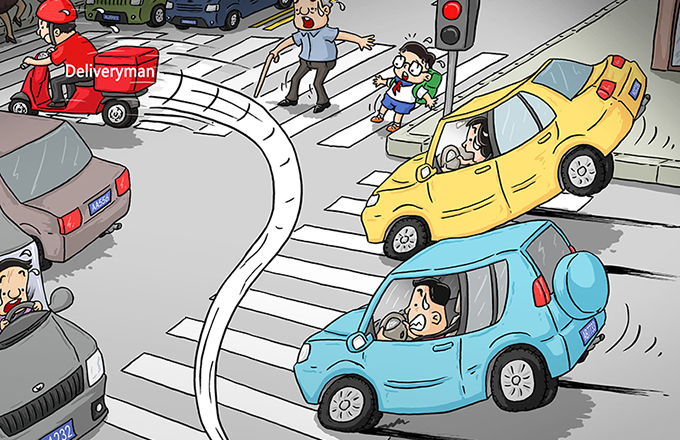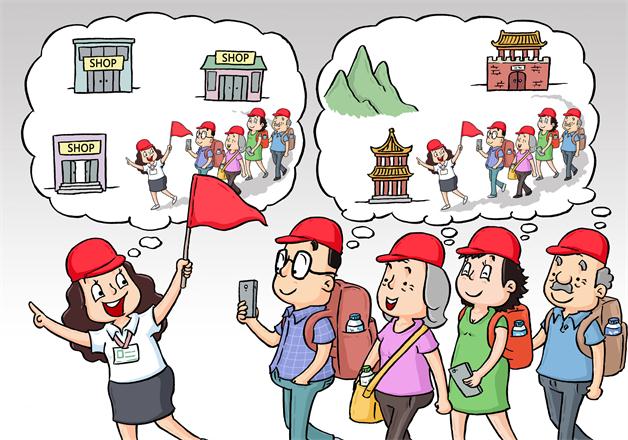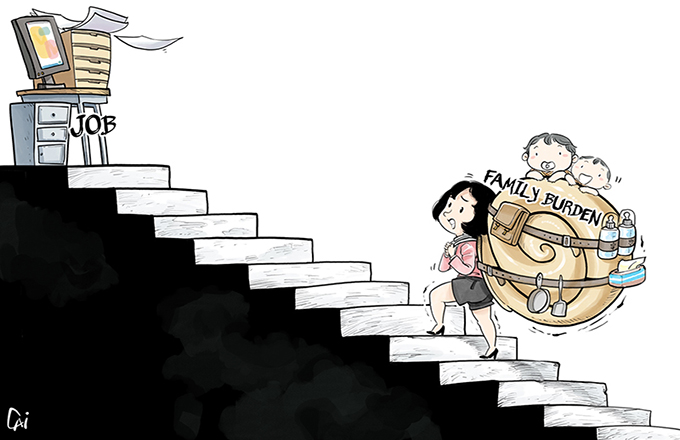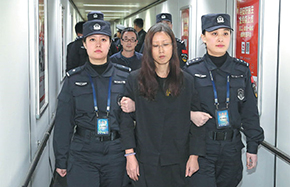Development of China's Public Health as an Essential Element of Human Rights
VI. Significant Improvement in the Health of Special Groups
The Chinese government attaches great importance to the protection of the right to health of special groups such as women, children, the elderly and the disabled. It constantly improves health programs, and provides diversified and targeted health services to meet the special needs of various groups in a nondiscriminatory and equal manner.
The maternal and child healthcare service system has been continuously improved. A three-level network of maternal and child healthcare service has been put in place in urban and rural areas. In 2016, the Chinese government invested RMB2.9 billion to support the construction of 247 city-and county-level maternal and child healthcare institutions. By the end of 2016, there were 3,063 such institutions, 757 maternity hospitals, 117 children's hospitals, and 370,000 gynecologists, obstetricians and pediatricians, and assistants. Full-time and part-time maternal and child healthcare workers were available in 34,000 community health centers (stations), 37,000 town and township health centers and 640,000 village clinics.
Antenatal and perinatal care services have been upgraded. Since 2009, the Chinese government has been expanding year by year the coverage of cervical cancer and breast cancer screening programs in rural areas, and the number of beneficiaries has grown. Between 2009 and 2016, the government carried out free cervical cancer screening for more than 60 million rural women aged 35-64 in 1,299 project counties, and subsidized more than 74 million rural pregnant and lying-in women with a special investment of RMB22.6 billion. The rate of hospital deliveries for rural women increased from 92.3 percent in 2008 to 99.6 percent in 2016, and rates of maternal and infant mortality in rural areas decreased sharply. The government arranged subsidies for 11 programs, including free pre-pregnancy examinations for healthy childbirth, hospital deliveries for rural women, supplementary taking of folic acid by rural women to prevent neural tube defects, and prevention of mother-to-child transmission of HIV, syphilis and hepatitis B. The targets of the Program for the Development of Chinese Women (2011-2020) have been met one by one.
Children's health has improved remarkably. In 2013, the pure breast-feeding rate of babies aged 0-6 months increased to 58.5 percent nationwide. The breast-feeding rate keeps growing. In 2016, infant mortality was 7.5 per thousand and that of children under five was 10.2 per thousand, both meeting the targets set in the UN Sustainable Development Goals and the Program for the Development of Chinese Children (2011-2020) ahead of schedule. This shows that the gap between China and developed countries is rapidly narrowing. In 2016, for children under five, the underweight and growth retardation rates, and anemia prevalence decreased to 1.49 percent, 1.15 percent and 4.79 percent, respectively-all meeting the targets set in the Program for the Development of Chinese Children (2011-2020) ahead of schedule. By the end of 2016, 30 state-level demonstration bases for children's early development had been set up. The government has implemented a program of nutrition improvement for children in poverty-stricken areas, providing one pack of nutritional dietary supplements containing protein, vitamins and minerals every day for every baby aged 6-24 months in impoverished areas. According to the fifth survey of Chinese children's physical development in 2016, in the past 40 years the physical development of children under seven improved rapidly, even higher than the child growth standards published by the WHO.
Children's disease control has been consolidated. In 2016, the rate of mother-to-child transmission of HIV decreased to 5.7 percent, and the incidence of neonatal tetanus was less than 1 per thousand. Children's vaccination rate under the national childhood vaccine program was more than 99 percent. The country remains polio-free, and has a low reported incidence of tuberculosis in children. In 2016, the screening rate of inherited metabolic diseases (phenylketonuria and congenital hypothyroidism) reached 96 percent, and the neonatal disease screening program for poor areas covered 354 counties (cities or districts) in 21 provinces (autonomous regions and centrally administered municipalities). The Chinese government has been carrying out major public healthcare service programs such as free pre-pregnancy examination for healthy childbirth, screening of neonatal diseases in poor areas, and pilot prevention and control of thalassemia.
The healthcare service system for the elderly has improved. By the end of 2015, there were 453 rehabilitation hospitals, 168 nursing homes and 65 nursing stations around China, up by 69.0 percent, 242.9 percent and 16.1 percent, respectively from 2010. The number of health personnel working in the above three kinds of institutions was 36,441, 11,180 and 316, respectively, up by 96.5 percent, 286.7 percent and 69.9 percent from 2010. In 2015, the government offered 118 million medical examinations to senior citizens aged 65 or above, a health management rate of 82 percent. The mental health of the elderly has also attracted full attention. Governmental and social organizations publicize related knowledge and provide mental health counseling to the elderly, while working to enrich their cultural life.
The combined medical and elderly care services have been promoted. In 2016, 90 cities (districts) were selected as state-level pilot units to provide combined medical and elderly care services. Across China there were 5,814 institutions providing both services, with a total of 1.2138 million beds. Of these, 3,623 were nursing institutions for the elderly that have established medical facilities, 1,687 were medical institutions that have added care services for the aged, and 504 were institutions offering both services. In total, 2,224 were among designated medical insurance institutions. Special steps have been taken to improve services at these nursing institutions for the elderly; as a result, we have seen a sounder quality control system and better services at these institutions combining medical service and ordinary care service.
Disability prevention and rehabilitation services for persons with disabilities have improved. In 2016, the Chinese government published the National Action Plan on Disability Prevention (2016-2020), and in 2017, the Regulations on Disability Prevention and Rehabilitation, bringing the work onto the track of the rule of law. From 2012 to 2016, 15.26 million people with disabilities received basic rehabilitation services nationwide. By the end of 2016, there were 7,858 rehabilitation institutions for the disabled around China, with 223,000 employees; and 947 municipal districts and 2,015 counties (cities) provided community-based rehabilitation services, with 454,000 coordinators. August 25 is China's Disability Prevention Day, as set in 2017.
Rehabilitation sports for the disabled have been expanded to more areas. The Chinese government has been working to improve basic sports facilities for the disabled since the 13th Five-Year Plan period (2016-2020). It has implemented a region-based guidance policy by advancing from west to east, from north to south and from the underdeveloped to the more-developed areas. Under this policy framework, the government has funded six western provinces (autonomous regions and municipalities directly under the central government) in introducing rehabilitation sports into 8,000 households, from which a national campaign started, offering services to 88,884 households. It also subsidized 50 communities in installing fitness facilities as demonstration sites, and subsequently 1,842 new ones were set up nationwide. Now people with disabilities who regularly participate in sports and fitness activities make up 9.6 percent of the national total, a percentage higher than before.
Orphans with disabilities receive special care. Since 2015, the Chinese government has included sick and disabled children among urban and rural residents entitled to basic living allowances and people living in dire poverty and entitled to relief and support, and orphaned and disabled children who remain unsettled, in the Tomorrow Plan for Rehabilitation of Handicapped Orphans. In addition, it offers medical rehabilitation to these children with reference to treatment policies and practices of welfare institutions. Thanks to the Tomorrow Plan, tens of thousands of children have had operations and been integrated into society after recovery. At welfare institutions, all children with surgical indications who are new to these institutions are able to get surgery at the optimal opportunity for treatment. By the end of 2016, the country had invested RMB860 million in offering corrective operations and rehabilitation training to more than 90,000 orphans with disabilities.





















